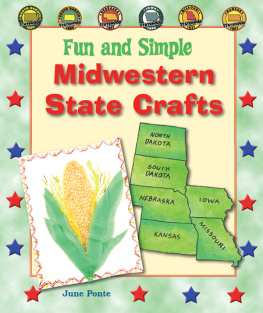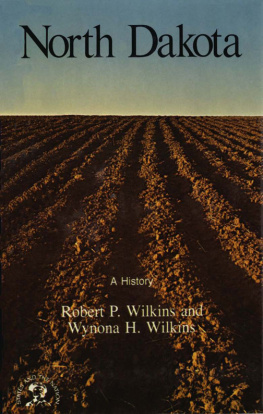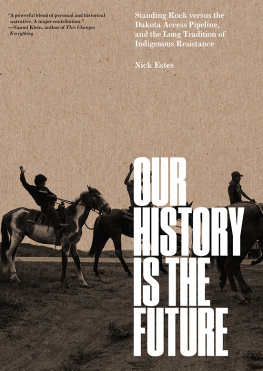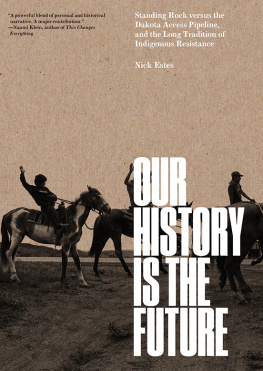
IMAGES
of Modern America
STANDING ROCK
LAKOTA, DAKOTA, NAKOTA NATION

THE GREAT SEAL. The great seal of the Standing Rock Sioux Tribe commemorates the reservation that was created in 1873.
ON THE FRONT COVER: Clockwise from top left:
The Grand River flows west and east through the Standing Rock Reservation (see ). (All images courtesy of Dennis J. Neumann, United Tribes News.)
ON THE BACK COVER: Clockwise from top left:
Students stand in front of a Mandan earth lodge, which was a living quarters on the Missouri River (Courtesy of Donovin Sprague); tipis are set up facing east, a highlight at the United Tribes International Powwow (Courtesy of Donovin Sprague; see ); and an unidentified woman participates in the Founders Day Powwow (Courtesy of Dennis J. Neumann, United Tribes News.).
IMAGES
of Modern America
STANDING ROCK
LAKOTA, DAKOTA, NAKOTA NATION
Donovin Arleigh Sprague and Rylan Sprague

Copyright 2015 by Donovin Arleigh Sprague and Rylan Sprague
ISBN 978-1-4671-1499-8
Ebook ISBN 9781439654576
Published by Arcadia Publishing
Charleston, South Carolina
Library of Congress Control Number: 2015942097
For all general information, please contact Arcadia Publishing:
Telephone 843-853-2070
Fax 843-853-0044
E-mail
For customer service and orders:
Toll-Free 1-888-313-2665
Visit us on the Internet at www.arcadiapublishing.com
Dedicated to the people connected to the Standing Rock Reservation.
CONTENTS
ACKNOWLEDGMENTS
Thanks go to the following individuals and organizations for their assistance in compiling this work: Dave Archambault II, Father Basil Atwell, Phil Baird, Russell and Cordelia Benoist, Earl Bullhead, Sam and Jace DeCory, Mary Louise Defender Wilson, Joe Flying By, Wilbur Flying By, Bill Gayton, David Gipp, Grand River Casino, Gladys Hawk, Mark Holman, Del Iron Cloud, Jean Katus, Tom Katus, George and Marilyn Keeps Eagle, KLND-FM, Kevin Locke, Dennis Neumann, Susan Kelly Power, Prairie Knights Casino, Mark Shillingstad, Charles Shoots the Enemy, Deb Sprague, Roger Sulcer, Jay Taken Alive, Jan Two Shields, United Tribes Technical Center, Frank White Bull, and the Sidney Whitesell family.
I want to especially thank Dennis J. Neumann of United Tribes Technical College for his interest in the tribal history and culture and for providing photographs and valuable information for the book. I also want to thank Mark Holman and KLND-FM for assistance. Finally, I want to thank coeditor Rylan Sprague and Deb Sprague for their assistance.
INTRODUCTION
The Standing Rock Reservation comprises 2.8 million acres and occupies territory in two states, North Dakota and South Dakota. Standing Rock was established as part of the Great Sioux Reservation. On April 29, 1868, the boundaries of the reservation were described under the Treaty of Fort Laramie. The Standing Rock Agency was later established in 1873. The Executive Order of March 16, 1875, extended the reservations northern border to the Cannonball River. However, in 1889, Congress reduced the Great Sioux Reservation, dividing it into six separate reservations, including the Standing Rock Sioux Reservation. There were four million acres in the territory when it was established in 1864. It was greatly reduced in size following the Indian Wars of the 19th century.
The reservation now has a land base of 3,571.9 square miles (9,251.9 square kilometers) and a population of 8,250. The communities on the reservation are Fort Yates, McLaughlin, Cannonball, Bullhead, Kenel, Little Eagle, Porcupine, Solen, Wakpala, Selfridge, McIntosh, and Morristown. Some Standing Rock communities are no longer within the reservation boundaries, but they are included because they have enrolled tribal members living there. Many community schools may transport enrolled tribal members by bus from rural areas into their schools.
Generally, the word Sioux refers to the Lakota, Dakota, and Nakota. Most of the people who reside on Standing Rock Reservation today are Lakota and Dakota and speak the L and D language dialects. Most of the Lakota who were here when the reservation was established were the Hunkpapa Lakota and the Sihasapa Lakota. The Hunkpapa are more numerous; the Sihasapa (Blackfeet) were split up between the two bordering reservations of Standing Rock and Cheyenne River. When the boundary lines were established, most of the Sihasapa were among the Lakota at Cheyenne River. Many of the Dakota speakers are on the North Dakota side of Standing Rock Reservation.
Sitting Bull, a Hunkpapa Lakota, was a highly respected leader and medicine man who led the Lakota in the 19th century and is the best-known former resident of Standing Rock. Noted leaders during this era included Running Antelope, Pizi (Gall), Rain in the Face, Crow King, Grindstone, Crawler, Mad Bear, Long Soldier, Moving Robe Woman (Mary Crawler), John Grass, Josephine Waggoner, Two Bear, One Bull, White Bull, Red Fish, Flying By, and many others. Many in this group went to Canada following the 1876 Battle of the Little Bighorn. In the 1880s, many surrendered from Canada and were placed with other tribal members residing at Standing Rock Agency. The Ghost Dance movement, the killing of Sitting Bull at Grand River, the Wounded Knee massacre, and Wild West shows were important historical events in the 1890s.
The Standing Rock Sioux Reservation operates under a constitution approved on April 24, 1959, by the tribal council under the auspices of the Indian Reorganization Act of 1934. The tribal council chairman and council members serve for a term of four years. Of the 14 additional council members, six can be residents of the reservation without regard to residence in any district or state. Each of the remaining council members must be a resident of the district from which they are elected. The tribe stands by its rights of self-governance as a sovereign nation, which includes a government-to-government stance with the states and federal government.
The Indian Reorganization Act of 1934 (IRA) created tribal constitutions and governments. Since then, most tribes have accepted this act and elected chairmen, presidents, principal chiefs, and executive directors as officers. Other elected offices include vice chairman, secretary, treasurer, and tribal councils. Standing Rock Reservation did not adopt the IRA in 1934. In the mid-1940s, the Standing Rock Nation operated under a tribal business council; it adopted a tribal constitution in 1959.
In 1946, an Indian Claims Commission was established by the US government, allowing tribes to file court claims against the United States for lands taken in violation of treaties, agreements, and amendments. At that time, the Lakota, Dakota, and Nakota filed a claim for the loss of the Black Hills, a sacred homeland. In the 1950s, tribes could lose their federal recognition status or be terminated as a tribe, in which case the tribe might cease to exist according to government law. Relocating the displaced tribes moved large numbers of American Indian people from their reservations into urban centers, resulting in an increase in the number of American Indians enlisting for military service.
As an affirmation of the rights of American Indian people, the Indian Civil Rights Act was passed in 1968, four years after the Civil Rights Act that was aimed at other minorities. In 1972, the Indian Self-Determination and Education Assistance Act allowed states more sovereignty, and tribes could contract their services to the US government. Most of these contracts are in the areas stipulated from treaties made with the United States and include education, health, housing, food supplement, social services, and other needs. Many of the programs on the reservation today come from these contracts.
Next page












